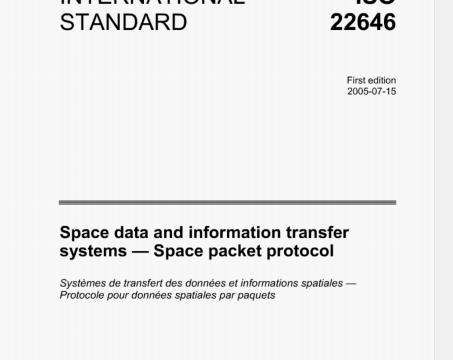ISO 22646 pdf download – Space data and information transfer systems -Space packet protocol.
e) peer entities;
I) pro(ocol control infornulion;
g) protocol data unit;
hI real system;
i) scgmcifling;
j) service;
k) Service Access Point tSAII;
I) SAP address;
m) service data unit.
1.6.1.2 Definitions from OSI Service Definition Conventions
This Recommendation rnakcs use of a numbcr of terms dctincd in refercnce 121. Thc use of those terms in this Recommendation shall be understood in a generic sense; i.e.. in the sense that those terms are generally applicable to any of a variety of technologies that provide for the cschangc of information between real systems. Those terms arc:
a) indication:
b) primitive:
C) request;
dl service provider;
e) service user.
1.6.1.3 Terms Defined in this Rcco,ninc.idation
For the purposes of this Recommendation, the following definitions also apply. Many other terms that pertain to specific items arc defined in the appropriate sections.
asnchronous: not .cvrnhrrrnoas (see below).
delimited: having a known (and finite) length; applies to data in the contest of data handling.
Mission Phase: a period of a mission during which specified communications characteristics are used. The transition between two consecutive mission phases may cause an interruption of the communications services.
Physical Channel: a stream of bits transferred over a space link in a single direction.
The Space Packet Protocol entity at the source end system either generates Space Packets from service data units supplied by the source user application, or validates Space Packets provided as service data units by the source user application. At the source and intermediate systems, the Space Packet Protocol cnhity examines thc Path ID of incoming Space Packets and routes them through appropriate suhnetworks using the mechanisms provided by the suhnetwork. Routing infomation (i.e.. mapping from Path lbs to suhnetwork addresses is provided to thc Space Packet Protocol entities by rnanagcrncnt. If thcrc arc multiple destinations for an LDP, multicasting of Space Packets may be performed by one or more Space Packet Protocol entities at the source end system and/or intermediate system(s).
2.1.3 Al)l)RISSING
Each LDP is uniquely identified by a Path ID. A Path ID consists of an Application Process Identifier (APID) and an optional APID Qualilicr,
An AND Qualifier identifies a naming domain for APIDs and APIDs arc unique only in a single naming domain. An AND naming domain usually corresponds to a spacecraft (or an element of a constellation of cooperating space vehicles). Each space project shall establish APIL) naming domains to be used in their project. The assignment of APIDs to LDPs within a naming domain is controlled by the space project that owns the naming domain. If a system (or a suhnetwork) handles only Space Packets associated with a single naming domain, the APID Qualifier need not be used in the system (or the subnctwork).
While the APID is contained in the Packet Primary Header of the Space Packet, the APID Qualifier does not appear in the data structure defined by the Space Packet Protocol. The value of the APID Qualifier is usually carried by a protocol (or protocols) of the underlying subnetworks.
If Space Packets are transferred over a space4o-ground or space-to-space communications link with one of the Space Data Link Protocols (references [BoHHSI. the Master Channel Identifier (MCID). carried by the Space Data Link Protocol and defined therein, shall be uscd as the APID Qualifier.
2.1.4 PROTOCOl. DESCRIPTION
The Space Packet Protocol is described in terms of:
a) the services provided to the users;
b) the protocol data units: and
c) the procedures performed by the protocol.
ISO 22646 pdf download – Space data and information transfer systems -Space packet protocol
